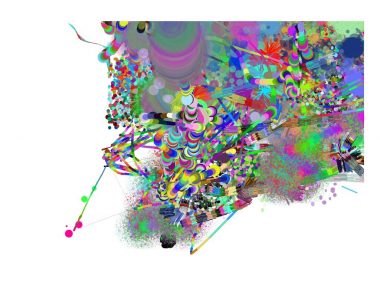‘Eye-gaze Artist’ Creates Designs to Promote Rett Awareness, Research
Emily Shifflet shows through her art that she is more than her disability

Emily Shifflet started painting after her behavioral therapist installed an eye-gaze art program on her computer. (Photo by Paul Nguyen)
Rett syndrome has left Emily Shifflet in a wheelchair and unable to communicate verbally, but through her art and her expressive personality, she speaks loud and clear.
Emily, 27, has a neurodevelopmental condition and that brings with it numerous challenges — long hospitalizations because of chronic lung disease, tube feeding, and seizures. She also endures bouts of acid reflux and constipation, and she has an enlarged colon that will sometimes cause her to cry out in pain.
But these problems haven’t stopped Emily from living out her life as fully as she can.
Emily lives with her parents on their family farm and gets to serve as the midwife supervisor whenever new calves are born. Every Tuesday, she is visited by her music therapist, where she plays the xylophone using adaptive equipment and sings along to the chorus of her favorite songs through her computer’s voice technology.
Her mother, Jenny Shifflet, also enjoys talking about Emily’s outsized personality. Emily is an extrovert and a flirt, and likes to go ice skating, participate in wheelchair yoga and salsa dancing, and volunteer as a greeter at the local United Service Organizations chapter.
Emily has also been part of the Patients as Teachers project at Penn State College of Medicine for the last 10 years. First-year medical students shadow Emily to learn more about her condition and how to assist people with complex medical illnesses. They get to spend six months with her and call her their first patient.
However, it’s through her art that Emily really shines, her mother said.
Emily discovered painting through an eye-gaze art computer program
Emily discovered painting through a program her behavioral therapist installed on her Tobii Eye Tracker, which tracks her eye movements to execute computer commands.
“Painting is something that she can use the only muscle that she has any real control over to express herself with color, with design,” Jenny Shifflet said from her home in Hummelstown, Pennsylvania, in an interview with Rett Syndrome News. “It’s something she can do with assistance to set up, but then she’s on her own; she can create on her own.”
It’s opened up a whole new world for Emily and has allowed her to become a silent partner in a business, a philanthropist, and a participant on a project for Rett Syndrome Awareness Month in October.
Emily’s abstract artwork is being featured in an awareness effort called Rett Revealed, sponsored by Acadia Pharmaceuticals. Anyone who is directly affected by Rett syndrome can upload a photo to the website’s landing page and it will be added to a mosaic based on Emily’s painting.
“Part of what we want to do through this project is to remind people that Emily is more than her disability,” Shifflet said. “Inside, there is a young woman who enjoys a lot of things that young women at that age enjoy.”
Emily comes from a large family who all support and embrace her, Shifflet added.

Emily Shifflet creates her compositions through the use of an eye-gaze device. This painting is available for purchase on the Eye Gaze Designs by Emily webpage. (Photo by Emily Shifflet)
Acadia found Emily’s work on her Instagram and Facebook pages and commissioned her to create the piece called “Confetti.” Hundreds of photos have been uploaded to help complete the mosaic. Showing the personalities of the people who have Rett syndrome was one of the goals for the project.
“We hear from parents and caregivers that their children are often underestimated or unfairly marginalized, whether in school, in a medical setting or in social activities, because they are unable to express themselves in a traditional way,” said Bill Keller, vice president of patient advocacy and industry relations for Acadia. “Rett Revealed features [Emily’s] art piece ‘Confetti’ as a way to demonstrate the uniqueness of every single person impacted by Rett syndrome.”
Acadia holds an exclusive license from Neuren Pharmaceuticals to develop and market trofinetide in North America. The therapy could potentially reduce inflammation in the brain and improve the health of nerve connections. Acadia’s new drug application for trofinetide as a treatment for Rett was accepted by the U.S. Food and Drug Administration in September.
Emily creates abstract art using a combination of computer-generated colors and brushstrokes offered by the DigitalPaint software. The paintings make use of almost every color available and are reminiscent of the whimsical backdrops from “Alice in Wonderland” or “Charlie and the Chocolate Factory.”
Great gift idea spurs business plan
Shifflet thought Emily’s designs would look great on notecards and make memorable family gifts.
The notecards went well and suddenly there was a demand for Emily’s art. So Shifflet started a small business, Eye Gaze Designs by Emily, and calls Emily her “silent partner.” The business sells holiday ornaments, calendars, prints, and notecards that feature Emily’s artwork.
Eye Gaze Designs by Emily has made more than $2,000 over the last two and a half years. The money goes directly to the Rett Syndrome Research Trust, a nonprofit organization that funds Rett research.
Besides being an activity Emily can participate in, the fledgling business gives her a sense of purpose, helping her to give back to her own community — something both Shifflet and her husband, Bob, have encouraged Emily to do.
“Let me tell you when you call her the eye-gaze artist, and she’s in a good mood, her eyes get bright, she lifts her shoulders up and her chest out,” Shifflet said. “She’s got a job just like all her friends.”








